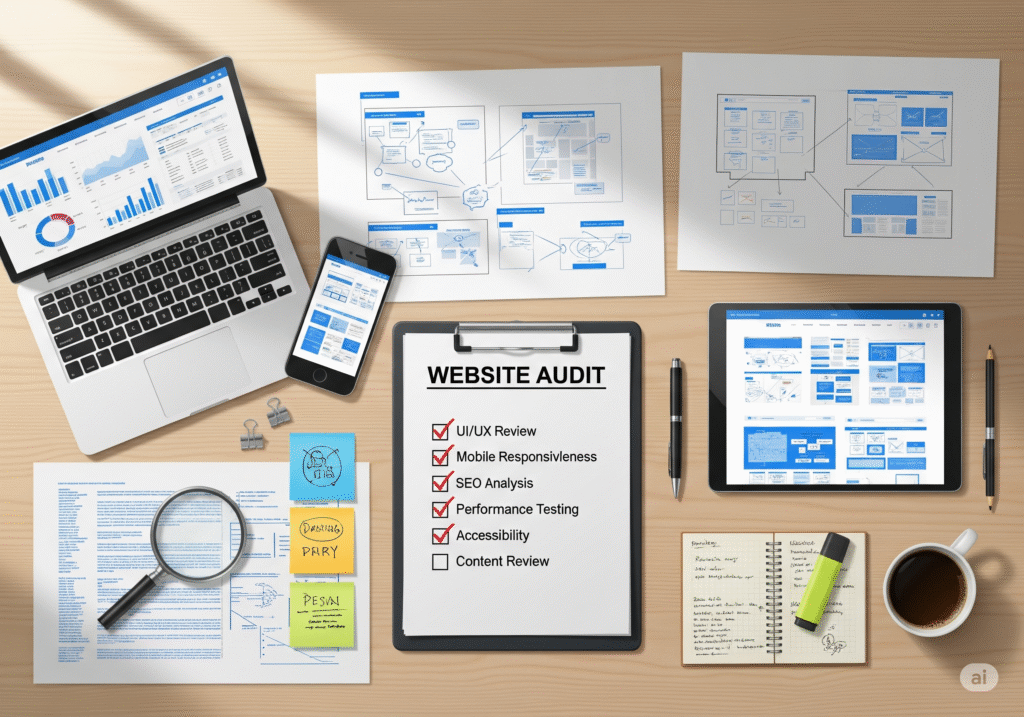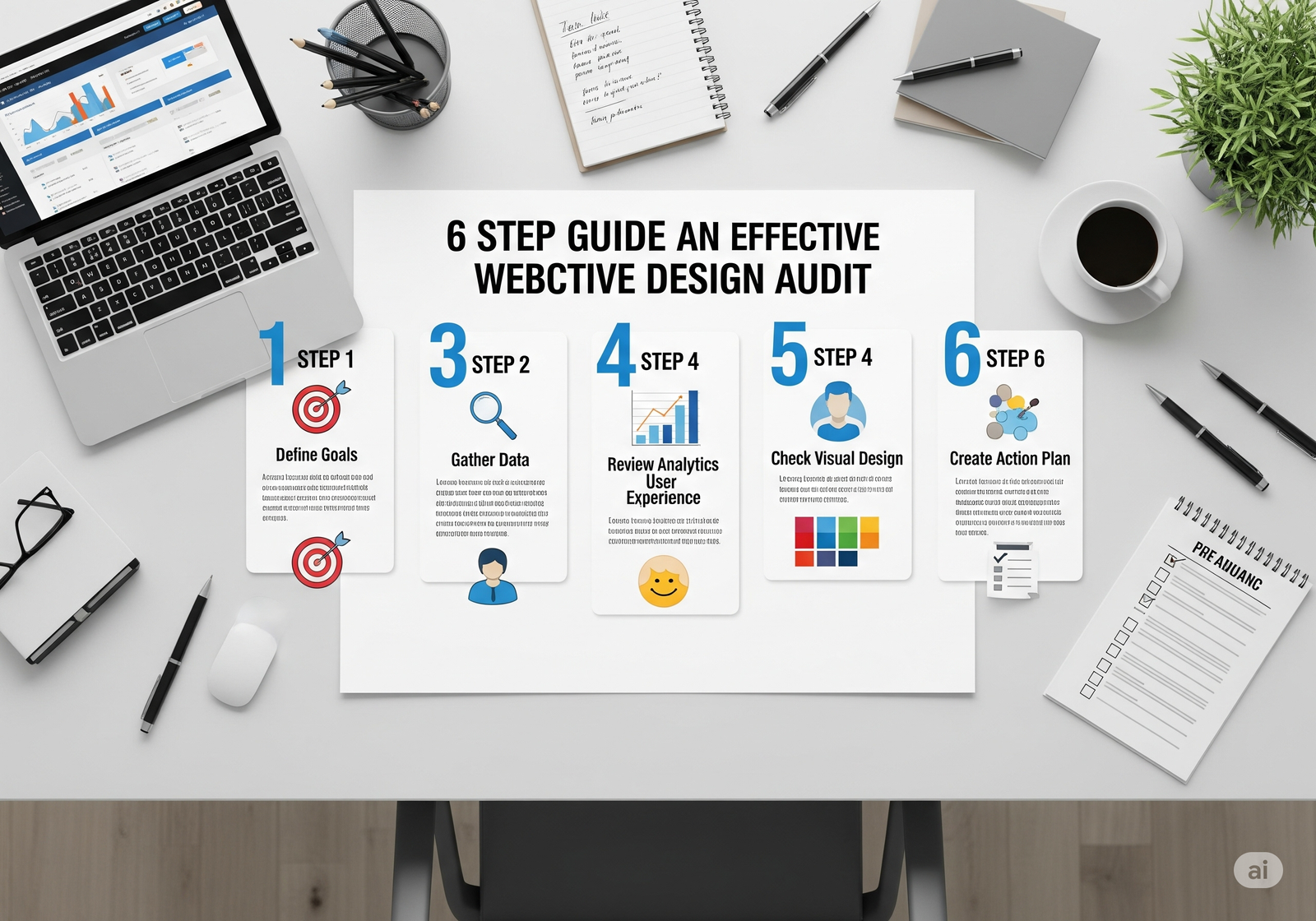How to Conduct a Web Design Audit: Fix SEO Issues
A website design audit represents one of the most powerful tools for identifying and resolving issues that prevent your website from achieving its full potential. As someone who has witnessed countless businesses struggle with declining traffic and poor conversion rates, I can confidently say that most problems stem from overlooked design and SEO issues that accumulate over time.
Your website might appear visually appealing, but hidden beneath the surface could be critical flaws affecting search engine rankings, user experience, and ultimately, your bottom line. These problems range from technical performance issues to outdated web design elements that no longer align with modern user expectations and search engine requirements.
The solution lies in conducting a systematic website design audit that examines every aspect of your digital presence. This comprehensive evaluation process helps identify specific areas requiring improvement while providing actionable insights for enhancing your website’s effectiveness.
In today’s competitive digital landscape, where web development technologies in 2025 continue evolving rapidly, regular auditing ensures your website remains current, functional, and optimized for success. Whether you’re planning a complete redesign or seeking to optimize your existing site, this guide will walk you through the entire audit process step by step.
Table of Contents
What is a Website Design Audit
A website design audit is a comprehensive evaluation process that analyzes your website’s visual elements, structural integrity, functionality, and alignment with current business objectives. Think of it as a thorough health checkup for your digital presence—just like medical examinations identify health issues and provide treatment recommendations, a design audit reveals problems and establishes improvement goals.

This systematic review process examines multiple dimensions of your website’s performance, from user interface design and navigation structure to technical performance and search engine optimization factors. The audit provides valuable insights into how effectively your website serves both users and search engines.
Core Components of a Website Design Audit:
Visual Assessment: Evaluating design consistency, branding alignment, color schemes, typography, and overall aesthetic appeal across all pages and devices.
Technical Analysis: Examining site speed, mobile responsiveness, browser compatibility, security protocols, and backend performance metrics.
User Experience Review: Analyzing navigation patterns, content organization, accessibility features, and conversion path effectiveness.
SEO Evaluation: Assessing on-page optimization, meta descriptions, keyword usage, internal linking structure, and search engine visibility factors.
Content Analysis: Reviewing content quality, relevance, freshness, and alignment with user intent and business goals.
A professional website design audit serves as the foundation for strategic improvements that enhance user satisfaction, improve search rankings, and drive business growth through optimized digital experiences.
Why Website Design Audits Are Essential for Success
Conducting regular website design audit processes has become crucial for businesses seeking to maintain competitive advantages in today’s dynamic digital environment. Here’s why these comprehensive evaluations are indispensable:

Enhanced User Experience
Modern web design must prioritize user-centric experiences that facilitate seamless navigation and engagement. A thorough audit identifies pain points in the user journey, revealing areas where visitors encounter friction or confusion. By addressing these issues, you create intuitive pathways that guide users toward desired actions while maintaining their interest and satisfaction.
Improved Search Engine Performance
Search engines continuously update their algorithms, making it essential to ensure your website meets current optimization standards. A website design audit examines critical SEO factors including page loading speeds, mobile responsiveness, structured data implementation, and content optimization. These elements directly impact your search rankings and organic traffic potential.
Higher Conversion Rates
The primary objective of most websites is converting visitors into customers, subscribers, or leads. Poor design choices, confusing navigation, unclear calls-to-action, and technical issues can significantly impact conversion performance. Regular auditing identifies barriers preventing users from completing desired actions, enabling targeted improvements that boost conversion rates.
Optimized Loading Performance
Website speed directly affects user experience, search rankings, and business revenue. Research indicates that even small increases in loading times can dramatically increase bounce rates and reduce conversions. A comprehensive audit evaluates performance bottlenecks and provides specific recommendations for achieving optimal loading speeds across all devices.
Increased User Engagement
Maintaining visitor engagement is crucial for guiding users through conversion funnels and building lasting relationships. Audits help identify engaging elements like interactive features, compelling content, and multimedia components that encourage users to spend more time exploring your website and returning for future visits.
Mobile App Branding is done perfectly by YAAM Web Solutions – delivering comprehensive audit solutions that transform website performance and user engagement.
Types of Website Design Audits
Different types of website design audit approaches address specific aspects of your digital presence. Understanding these variations helps you choose the most appropriate audit strategy for your current needs:

Competitive Web Design Analysis
This audit type focuses on comparing your website’s performance against industry competitors. By analyzing competitor strengths, weaknesses, opportunities, and threats, you gain valuable insights into market positioning and identify areas for differentiation. This analysis reveals industry best practices while highlighting untapped opportunities for competitive advantage.
SEO Technical Audit
A specialized website design audit that examines your site’s technical SEO foundation. This includes evaluating backlink quality, identifying toxic links that may harm rankings, analyzing keyword optimization, and assessing overall search engine visibility. Tools like comprehensive SEO platforms help determine which links benefit your site and which require removal or disavowal.
Conversion Optimization Review
This audit focuses specifically on converting website visitors into leads or customers. If your site receives substantial traffic but generates few conversions, this type of evaluation identifies specific barriers preventing users from taking desired actions. The review examines user flow, form optimization, call-to-action effectiveness, and landing page performance.
Technical Performance Assessment
A detailed examination of your website’s technical infrastructure, including server response times, code optimization, database performance, and hosting environment efficiency. This audit type is particularly valuable for sites experiencing performance issues or planning for increased traffic volumes.
User Experience Evaluation
Focused specifically on how users interact with your website, this audit examines navigation patterns, content accessibility, mobile usability, and overall user satisfaction. It often includes user testing sessions and behavioral analysis to provide comprehensive insights into the user experience.
Key Benefits of Conducting Website Design Audits
Regular website design audit processes deliver significant advantages that directly impact business success and digital performance:

1. Enhanced Search Engine Rankings
A comprehensive website design audit goes beyond surface-level aesthetics to examine critical SEO factors that influence search engine rankings. By identifying and addressing technical issues, optimizing content structure, and ensuring mobile compatibility, audits help your website achieve higher visibility in search results, leading to increased organic traffic and better business outcomes.
2. Improved Website Usability
As web design standards evolve and user expectations change, regular auditing ensures your website remains accessible and user-friendly for all visitors. This includes evaluating navigation structure, content organization, and ensuring compliance with accessibility guidelines, creating positive experiences that encourage user engagement and return visits.
3. Strengthened Brand Consistency
Web design trends continuously evolve, and maintaining brand relevance requires periodic evaluation and updates. A design audit helps ensure your website accurately represents your brand identity while staying current with modern design principles. This consistency builds user trust and maintains competitive positioning in your market.
4. Increased Conversion Performance
By identifying obstacles in your conversion funnel, a website design audit reveals specific areas where potential customers abandon their journey. Addressing these issues through targeted improvements can significantly increase conversion rates, directly impacting revenue and business growth.
5. Better User Engagement Metrics
Audits help identify content and features that resonate most effectively with your audience while revealing areas where users lose interest. This insight enables strategic improvements that increase time on site, reduce bounce rates, and encourage deeper engagement with your content and offerings.
Essential Elements of a Comprehensive Website Design Audit
A thorough website design audit must evaluate multiple interconnected aspects of your website’s performance and effectiveness. Here are the critical components that should be included:

1. User Experience Analysis
User experience forms the foundation of effective web design, determining how visitors interact with and perceive your website. This evaluation should examine:
Navigation Structure: Assess whether users can easily find desired information within two clicks. Well-designed navigation reduces frustration and improves user satisfaction by providing clear, logical pathways to important content.
Mobile Optimization: With increasing mobile device usage, ensuring your website performs excellently across all screen sizes is essential. This includes responsive design implementation, touch-friendly interfaces, and optimized mobile user flows.
Page Loading Speed: Slow-loading pages significantly impact user experience and search rankings. Utilize tools like Google PageSpeed Insights to identify performance bottlenecks and optimization opportunities.
Content Clarity and Organization: Evaluate whether your content is well-structured, easily scannable, and provides clear value to users. Effective use of headings, bullet points, and concise language improves overall usability.
Call-to-Action Effectiveness: Review the placement, design, and messaging of calls-to-action to ensure they’re compelling and strategically positioned to guide users toward desired actions.
Accessibility Compliance: Ensure your website meets WCAG guidelines, making it accessible to users with disabilities while improving overall usability for all visitors.
2. Visual Design Evaluation
Strong visual design creates positive first impressions and reinforces brand identity throughout the user experience:
Brand Consistency: Evaluate whether fonts, colors, imagery, and overall design elements consistently reflect your brand identity across all pages and sections.
Visual Hierarchy: Assess how effectively your design guides users’ attention to important elements and information through strategic use of size, color, and positioning.
Image Quality and Relevance: Review all imagery to ensure high quality, brand alignment, and relevance to your target audience and messaging.
Typography Assessment: Evaluate font choices, readability, and text spacing to ensure optimal user experience across different devices and screen sizes.
Color Scheme Effectiveness: Analyze your color palette for visual appeal, brand alignment, and sufficient contrast ratios for accessibility compliance.
3. Technical Performance Review
The most visually appealing website becomes ineffective if it doesn’t perform reliably:
Site Speed Optimization: Comprehensive evaluation of loading times, image optimization, code efficiency, and server performance to ensure fast, responsive experiences.
Security Implementation: Verify SSL certificate installation, security protocol implementation, and protection against common vulnerabilities.
Cross-Browser Compatibility: Test functionality across different browsers and devices to ensure consistent performance for all users.
SEO Technical Factors: Analyze meta descriptions, title tags, header structure, internal linking, and other on-page optimization elements that impact search engine rankings.
Warning Signs Your Website Needs an Immediate Audit
Recognizing when to conduct a website design audit can prevent small issues from becoming major problems. Here are clear indicators that your website requires immediate attention:
1. Declining User Engagement Metrics
If your website analytics show decreasing page views, shorter session durations, or increasing bounce rates, these metrics indicate potential user experience problems. A comprehensive website design audit can identify specific issues causing users to leave quickly and provide solutions for improving engagement levels.
2. User Experience Problems
When visitors struggle to navigate your website, find information, or complete desired actions, it signals fundamental usability issues. Signs include high form abandonment rates, frequent customer service inquiries about website functionality, or negative feedback about user experience.
3. Outdated Visual Design Elements
Websites that appear outdated can damage brand perception and reduce user trust. If your design elements, imagery, or overall aesthetic haven’t been updated recently, they may no longer align with current web design standards or accurately represent your brand.
4. Inconsistent Design Implementation
Mixed messages, conflicting visual elements, or inconsistent functionality across different pages create confusion and undermine professional credibility. Design inconsistencies suggest the need for comprehensive evaluation and standardization.
5. Poor Technical Performance
Slow loading times, frequent downtime, mobile compatibility issues, or low conversion rates indicate technical problems requiring immediate attention. These issues directly impact user experience and business results, making prompt resolution essential.
6-Step Guide to Conducting an Effective Website Design Audit
Conducting a thorough website design audit requires systematic evaluation of multiple website components. Here’s my proven six-step process for comprehensive assessment:

Step 1: Define Your Target Audience
Before beginning the audit process, establish clear understanding of your users’ needs, preferences, and behaviors. Utilize analytics tools like Google Analytics and user research platforms to gather data about visitor demographics, interests, and interaction patterns. Creating detailed user personas helps focus improvement efforts on elements that matter most to your actual audience.
Step 2: Analyze Performance Metrics
Examine key website metrics including bounce rates, average session duration, conversion rates, and traffic sources using Google Analytics and SEMrush. These metrics reveal areas requiring attention and help establish baseline measurements for tracking improvement success.
Step 3: Conduct Comprehensive UX Review
User experience evaluation forms the core of any effective website design audit. This step requires thorough analysis of how users interact with your website:
Heatmap Analysis: Tools like Hotjar provide valuable insights into user behavior through heatmaps and session recordings, showing exactly where users click, scroll, and exit your site.
Usability Testing: Platforms like UsabilityHub offer testing tools that reveal user behavior patterns, navigation preferences, and interaction difficulties.
User Journey Mapping: Crazy Egg’s heatmaps and scroll maps help understand how far users scroll and where they lose interest, providing crucial insights for content organization and page structure optimization.
Step 4: Evaluate Visual Design Elements
Conduct systematic review of your website’s visual components and overall design coherence. Assess whether the design appears current, maintains consistency across all pages, and accurately represents your brand identity. Gather user feedback through surveys or testing tools to understand how visitors perceive your visual design.
Step 5: Test Accessibility, Responsiveness, and Performance
Ensure your website functions flawlessly across all devices including desktops, tablets, and mobile phones. Use Google PageSpeed Insights to measure current performance and identify optimization opportunities. Verify W3C compliance to ensure accessibility for users with disabilities, which also improves overall website usability.
Step 6: Analyze Results and Implement Improvements
After collecting comprehensive data, prioritize identified issues based on their impact on user experience and business objectives. Develop an implementation plan with your team to address the most critical issues first, then continue making improvements based on audit findings.
Best Practices for Successful Website Design Audits
Implementing effective website design audit processes requires following proven best practices that ensure comprehensive evaluation and actionable results:

1. Comprehensive Documentation
Thorough documentation is essential for effective audit completion and future reference. Record initial designs, identified issues, and planned improvements to create a clear paper trail of all decisions and changes. Maintain detailed records that team members can reference throughout the implementation process. Consistent naming conventions and design style guides help ensure that improvements are applied correctly and consistently across your website.
2. Utilize Professional Tools
The right tools significantly streamline the audit process and provide more accurate insights. Essential web design analysis tools include Ahrefs for SEO analysis, Google Analytics for performance metrics, and Hotjar for user behavior insights. Project management platforms like Trello or Asana help organize tasks, track progress, and ensure deadlines are met throughout the improvement process.
3. Establish Realistic Expectations
Setting achievable goals and timelines during the initial audit phases prevents frustration and ensures sustainable progress. Design audits often reveal more issues than initially expected, so allowing adequate time and resources for comprehensive improvements is crucial. Rather than attempting to address everything simultaneously, prioritize changes based on impact and feasibility to maintain steady progress toward your objectives.
4. Focus on User-Centric Improvements
Every audit finding should be evaluated through the lens of user experience and business impact. Changes that improve user satisfaction and support business objectives should receive priority over purely aesthetic modifications. This approach ensures that your website design audit delivers meaningful results rather than superficial improvements.
5. Plan for Ongoing Evaluation
Website optimization is an ongoing process rather than a one-time project. Establish regular audit schedules to ensure your website continues meeting evolving user expectations and web technologies standards. Quarterly or bi-annual audits help identify emerging issues before they significantly impact performance.
The Critical Connection Between Web Design and SEO
One of the most common mistakes businesses make is treating web design and SEO as separate, unrelated disciplines. In reality, these elements are deeply interconnected and dependent on each other for optimal performance.

How Design Impacts SEO Performance
Effective web design elements directly influence search engine rankings through multiple factors:
Mobile Responsiveness: Search engines prioritize mobile-friendly websites, making responsive design essential for maintaining visibility in search results.
Site Speed Optimization: Fast-loading pages improve user experience while boosting search rankings, as page speed is a confirmed Google ranking factor.
Navigation Structure: Clear, logical navigation helps search engines understand and index your content while improving user experience metrics that influence rankings.
Content Organization: Well-structured content with proper headings, internal links, and logical hierarchy helps both users and search engines understand your information.
SEO Elements That Require Design Support
Technical SEO strategies need design system support to achieve maximum effectiveness:
Keyword Integration: Strategic keyword placement requires design layouts that naturally incorporate target terms without compromising readability or user experience.
Meta Information: Title tags and meta descriptions must work within design constraints while providing compelling reasons for users to click through from search results.
Internal Linking: Effective internal link strategies require thoughtful design implementation that guides users naturally through your content while supporting SEO objectives.
According to Moz’s latest research, page speed and mobile usability are among the top ranking factors affecting website visibility in search results.
This interconnection between design and SEO is precisely what a comprehensive website design audit reveals. By evaluating how your site’s visual elements complement its technical optimization, you can identify and resolve disconnects that prevent optimal performance.
Why Choose YAAM Web Solutions for Your Website Design Audit
When it comes to conducting professional website design audit services, partnering with experienced experts ensures comprehensive evaluation and actionable results. As a leading top web development company, YAAM Web Solutions specializes in delivering thorough audits that identify critical issues and provide strategic solutions for improvement.

Our Comprehensive Audit Services:
Complete Website Analysis:
- In-depth website design audit covering all technical and visual elements
- User experience evaluation and optimization recommendations
- SEO performance analysis and improvement strategies
- Mobile responsiveness and cross-browser compatibility testing
Advanced Technology Integration:
- Assessment of current web technologies implementation
- Recommendations for web development technologies in 2025 adoption
- Performance optimization using cutting-edge tools and techniques
- Security evaluation and enhancement protocols
Strategic Business Alignment:
- Evaluation of website effectiveness in supporting business objectives
- Conversion optimization analysis and recommendations
- Brand consistency assessment and improvement planning
- Competitive analysis and positioning strategies
Our Proven Audit Process:
Discovery Phase: We begin by understanding your business goals, target audience, and current challenges to ensure our audit addresses your specific needs.
Comprehensive Analysis: Our team conducts systematic evaluation of all website components using professional tools and proven methodologies.
Detailed Reporting: You receive comprehensive reports with prioritized recommendations, implementation timelines, and expected impact assessments.
Implementation Support: We provide ongoing guidance and support throughout the improvement process, ensuring successful resolution of identified issues.
Why YAAM Web Solutions Stands Out:
Extensive Experience: Our portfolio demonstrates successful website design audit projects across diverse industries, from small businesses to enterprise organizations.
Technical Expertise: We stay current with the latest web design trends, SEO requirements, and performance optimization techniques.
Business-Focused Approach: Every recommendation aligns with your business objectives and provides measurable value for your investment.
Ongoing Partnership: We offer continued support and periodic re-evaluation to ensure sustained website performance and optimization.
Ready to discover what issues might be holding back your website’s performance? Visit www.yaamwebsolutions.com to schedule your comprehensive website design audit and unlock your site’s full potential.
Conclusion
A comprehensive website design audit represents one of the most valuable investments you can make in your digital presence. Through systematic evaluation of design elements, user experience factors, technical performance, and SEO optimization, audits reveal critical issues that may be preventing your website from achieving its full potential.
The process extends far beyond surface-level aesthetics to examine the fundamental elements that drive user engagement, search engine visibility, and business success. From identifying usability barriers that frustrate visitors to uncovering technical issues that impact loading speeds, a thorough audit provides actionable insights for meaningful improvement.
As web technologies continue evolving and user expectations rise, regular auditing ensures your website remains competitive, functional, and aligned with current best practices. The interconnected nature of design and SEO means that addressing issues holistically rather than in isolation produces the most significant results.
Whether you’re experiencing declining traffic, poor conversion rates, or simply want to ensure optimal performance, conducting a professional website design audit provides the foundation for strategic improvements that deliver measurable business impact.
The key to success lies in approaching audits systematically, utilizing appropriate tools and expertise, and implementing improvements based on data-driven insights rather than assumptions. By following the comprehensive process outlined in this guide and partnering with experienced professionals when needed, you can transform your website into a powerful tool for achieving your business objectives.
Don’t let hidden issues continue limiting your website’s performance. The time to conduct your website design audit is now—your users, search rankings, and bottom line will thank you for it.






One Comment